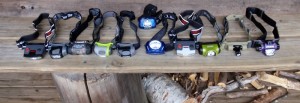
In the days when dinosaurs still roamed the earth, the first camping headlamps came out. And, just like the dinosaurs, they were bulky, heavy, and dim. The first one any of us carried looked like an old-style doctor’s reflector; about 3 inches around, with a battery pack wired on the back of it that held 4AA batteries. They’d last a night or two, and the light it gave was barely visible under a full moon. Years went by, and smaller units with halogen bulbs came along…a significant improvement, but they were still relatively heavy battery hogs.
LED technology changed all that. And one light in particular, the Princeton Tec Aurora, caught the fancy of many of us. Small and light, it had three levels of brightness, making it useful for both finding our way back to camp and reading in our tents. At last count, there were at least a half dozen in use among the EasternSlopes.com cast of characters.
But, times change, and LED is no longer an emerging technology. Obviously, advancements had been made over the years, but was it really worth moving up to new units? Time to test!
Testing Today’s LED Headlamps
We rounded up a range of lights, all based on a 3AAA battery setup. It seems to us that 4.5 volts is the “sweet spot” for camping: enough voltage for brightness, but relatively little bulk and weight. Many manufacturers are using that formula, so it’s likely that if you grab a headlamp off a camping store’s shelf, that’s what you’ll get. But…which one should you grab?
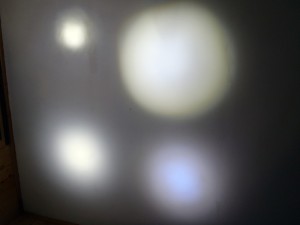
As usual, the answer is “it depends.” In particular, it depends on your personal preferences and needs. Do you like to hike at night? Do you chase down nightcrawlers, or want to get to a particular spot to watch a meteor shower? Is your main reason for camping being able to lie down in your tent at night and read without anyone bothering you? Or, do you participate in extreme activities where bulletproof is THE main factor?
A perfect task light is bright, focused, with an even beam pattern, but may be too bright for reading; a great light for hiking has a bright, focused center with a wide area that’s less bright to allow your peripheral vision to work. Pick the wrong light, and you’ll significantly reduce your enjoyment of what YOU want a light for.
Probably the first choice you need to make is…do you want a unit with a red light in it or not? For the majority of people, red is simply not necessary. Red light has the advantage of not messing up your night vision; that’s why airplanes have red lighting on the instrumentation. However, there are a limited number of situations where you would use it. If you happen to be someone who reads a lot of maps in the dark, you would want it; however, you also probably work for the CIA and have a particular government-issue unit anyway. For some campers, the idea of being able to walk to a vantage point for stargazing without losing any night vision is a real plus. And, seriously, nightcrawlering (in some parts of the country, that actually IS a verb) is much easier with a red light (the little buggers don’t react as much to it, so you can be slower and STILL have your bait to catch breakfast). If you’ve never used a red light before, you may want to consider buying a light with it and play with it; the cost and weight penalties in this group are low, and you might find that you’re one of the people who loves having it!
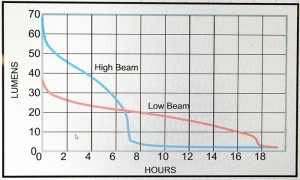
So, with no further fanfare, here’s the results of our Today’s LED Headlamps, broken down into white only/white & red. Testing was done with new Duracell AAAs; weights listed include the batteries (let’s face it, how useless its it to know how much a light weighs WITHOUT batteries???). Lumen output is per manufacturer’s specifications. Please realize that those ratings are with fresh batteries; none of these units uses a regulated power supply, so light output drops quite rapidly in use (see chart). That’s a great reason to use rechargeable batteries…each time you go out, you’re getting the maximum output from your headlamp without throwing away relatively good batteries (although rechargeables can shut down VERY quickly, so being able to replace your batteries in the dark is an incredibly important skill to learn). Read on, and see which description sounds most like YOU!
White Only Headlamps
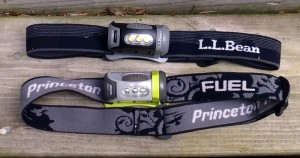
Princeton Tec Fuel/L. L. Bean Trailblazer ($15 and up street price; 2.7 oz. 35 lumens on high.) This is the “small and light” of the test, with a tiny barrel-shaped form that easily tucks into a pocket and 3 LEDs (see below for an update!). The Bean version is simply the Fuel rebranded as the Trailblazer; buy it from them, and get the famous Bean warranty along with Princeton Tec quality. The beam pattern is nice and broad, but is oddly cut off at the bottom on the Bean version. We contacted Bean about that, and it appears to be sample variation from Princeton Tec’s manufacturing; there’s no difference in spec between the two lights (another good reason to buy from a place with a great return warranty!). It’s a generally good performer; bright and focused enough for a task light, light, compact, relatively easy to use (although the button can be difficult to find with gloves on). A good choice if you are someone who uses your headlamp around camp, in their tent, reading, general relatively close-up tasks, but also does some nighttime walking. UPDATE: The Fuel is now available in a 4 LED version; same size, more brightness (43 lumens), a few more dollars. We haven’t tested it yet, but expect it to be similar to the current one based on design.
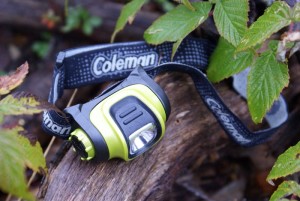
Coleman High Power ($25 MSRP; 3.6 oz. 75-15 lumen range.) The shock of the test. Cheap and easily available at outlets like Wal-Mart, it has a bright (75 lumens on high), wide beam pattern with a spotlight effect in the center. It’s effective for walking; the spotlight goes where you’re aimed, while the dimmer light around the perimeter allows you to use your peripheral vision. As a task light, the spotlight center can be a bit TOO focused and small, requiring you to pay close attention to aiming it just right, but it’s still more than adequate. And, with three light levels, it’s acceptable for reading (with the same caveat as task light…you have to make sure you’re either aiming the center spot AT what you’re reading, or using it on a brighter setting and making sure the center isn’t hitting the page). The switch is rotary and on the side of the unit; it’s easy to use even with heavy gloves on. For the money, unbeatable. Most likely user: Bargain hunters and people who left their main light at home and needed to grab something on the way…and who just might never go back to their other light!
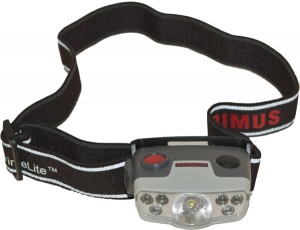
Primus PrimeLite CT ($66 MSRP; 3.6 oz. 45 lumens on high.)- This is perhaps the best light we tested for the night hiker. It has an odd beam pattern for walking with the side lights, so switch to the large Luxeon center LED (save the side lights for use in and around camp). Immediately, we noticed that it is very similar to the Coleman in pattern, but smoother; the transition from the center to the edges was more gradual, creating an almost flawless match for what our eyes wanted. Interestingly enough, the Luxeon is also more yellow than the side LEDs, and while we were initially disappointed with that, we found that it did a better job of cutting through fog and haze than the whiter lights did. It’s a large light physically, although not the heaviest in the group. Another advantage is that it’s waterproof to IPX7 standards (immersion to 1 meter for 30 minutes); you’ll still have light to find your way home after you fall into a river! Biggest weakness? Price; it’s the most expensive of the group by far. Still, if you’re primarily a night hiker and want a single “do it all” headlamp, this is your best choice.
Red lights:
We found a fascinating level of variation among the three lights that included a red option. It’s clear that the technology of red LEDs isn’t up to what’s happening in the world of white; that’s no surprise, given that there’s dramatically more uses for white LEDs, so more research and manufacturing dollars head in that direction. Still, these three lights offered function beyond the white-only headlamps; take a look and see if one is right for you!
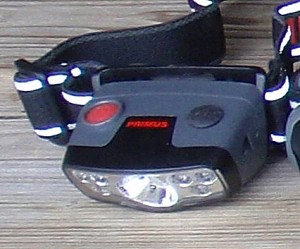
Primus PrimeLite CA ($78 MSRP; 3.6 oz. 45 lumens on high.) This is effectively the PrimeLite CT with fewer side LEDs and a red beam replacing them. So, take the comments above, and add in “it has red, too”…you’ve pretty much got what this is. The red beam pattern is great for reading maps, or reading in your tent without irritating the others in there who are trying to sleep, but too diffuse for walking; you can certainly get around, but the light doesn’t have the kind of intensity and penetration that’s ideal for night hiking. So…if you’re a night hiker who uses white light, great; but if you’re a night hiker who uses red, not so much. Still, for someone who hikes at night mostly with white light but wants a red option, this is likely the top choice.
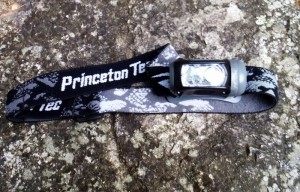
Princetontec Remix($30-35 street price; 3.0 oz. 100 lumens on high.)- Pretty much the opposite of the PrimeLite CA…if your goal is to use the red light for hiking, this is your lamp. No, it’s not as bright as the white headlamps (red never is, partially because of the way our eyes work), but as long as you’re sensible and not trying to walk too fast, it works; it’s bright enough, and has the best red beam pattern of any we tried. Beyond that, it’s a great beam pattern for nightcrawlering; if you’re a fisherman, you know that white light makes them shoot into their holes. Use red, and they’re a LOT easier to grab!
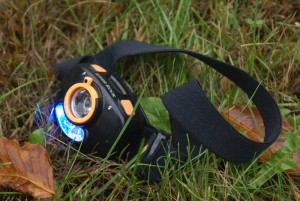
River Rock TekTrek ($35; 3.9 oz. No rating given.) This appeared late in the test, from a company that we’d never heard of…and utterly blew us away. Without question, the smoothest, most consistent beam pattern of ANY headlamp we’ve ever tried, and possibly the best we’ve seen from any LED flashlight, period…and that’s with a focusing beam that goes from flood to spot. Bright? Even on its lowest setting (10% of brightest), and with the beam focus on its widest, it’s on the bright side for reading…but wonderful for that purpose, as the smooth pattern means no trying to keep it aimed directly at the page. On full power, it’s a blowtorch. As a task light, it’s phenomenal; absolutely without peer in this test. Walking? The beam is too focused and small (even in the full floodlight setting) to be ideal for that, and there’s NONE of the dimming around the perimeter that we prefer. Still, if your main use is for tasks around the camp, you can still walk with it. Other nice touches include a water resistant design, continuously adjustable power from 100% to 10%, and blue/green/red LEDs. Frankly, we still haven’t found a use for the blue and green, other than making things look funny, but there’s no real loss to them being there, either. The red LED pattern is a weak spot; it’s broken up quite a bit. But, it’s quite bright, and functional for night walking. River Rock is a company to watch; if their other products live up to this one, we’ll be seeing a lot more from them!
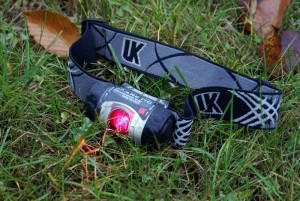 Underwater Kinetics Vizion
Underwater Kinetics Vizion>($45; 4.0 oz. 65 lumens on high, 35 on low.) UK has been known for years as a manufacturer of lights that work when they absolutely HAVE to. Their market has mainly been commercial uses, fire departments, scuba divers (one editor used their products 20 years ago when he was doing semi-professional diving). The Vizion is their foray into the general sportsmen’s market, and it definitely was designed based on that background. Light levels? Only two, and no strobe setting, either. Colors? Red, sure, but done with a filter, not an extra LED. Want to use it for reading? There’s a rotating diffusion filter on the OUTSIDE of the lamp, so it won’t compromise the waterproofness. How waterproof? Try 33 feet…like we said, UK has always been serious about that issue. Size? Relatively large and heavy for the features, because that’s necessary to make sure it’s waterproof and unbreakable, yet not dramatically larger than the PrimeLites. This light is a total beast and may outlive you. It’s a decent overall performer without being particularly great at anything. When white, it’s bright enough for hiking and task use without being the brightest, dim enough for reading even if not ideal. The red filter effect is…weird. There’s a lot of white overspill, so it won’t protect your night vision perfectly the way a true red LED will, but it’s amazing for reading maps; it creates contrast on the maps almost like a blacklight, and water shows up ridiculously well. One cute bonus; the batteries and LED come out of the housing in a capsule (part of the waterproofing system), and the capsule can be used as a lantern in your tent/cabin…like the rest of the features of the light, it’s not perfect, but not bad. When pressed, several testers said that if they HAD to own only one light and their lives would potentially depend on it ALWAYS working, this would be their choice. It’s hard to argue with that perspective; none of us found that we were unhappy when we had to use it for a night.

The best news is that ALL of the lights outperformed our old Auroras dramatically. Sometimes, “newer” means “maybe no better, maybe even worse.” When it comes to LED headlamps, that’s not true. There’s not a single one of these lights that we’d be unhappy with; while we found that some were better than others at certain things, if we had a 5 year old headlamp and someone tossed us one of these, it’d be a no-brainer to keep the new one. With the range of features and prices available, there’s no reason to NOT buy one if you don’t own one…and if you do own one, you may just want to take it in to your favorite outdoor retailer and compare the output, beam pattern, and features to the new crop…just make sure to take your wallet with you!


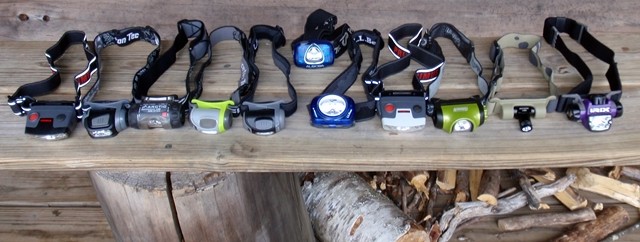
Coleman has a newer light than the one you tested and I just bought one on strength of your review. It’s called a Max and has 108 lumens vs 75 plus it has a set of red and blue LEDs. I have a Petzel which is good but coming off Big Slide in the dark I had to lend it to another hiker to wear while I used an Eddie Bauer dynamo which is clearly not ready for prime time. I had to crank it every few steps to keep the light bright. That is truly an emergency light only and I would say it’s the light you use when you need to find your ‘real’ light. The Max was $25 at WalMart and the 75 lumen one you reviewed was $20. The thing I would change on the new one is the color because it has a black plastic housing and I generally try to avoid black in my gear gear as night falls quick and it’s very easy to lose. I suspect other colors are available. Also I’d rather have two AAs rather than three AAAs. AAAs are used in very few products and are often tough to find or have been on the rack for quite a long time. I carry extra AAAs for the Petzel but always pray I would never have to change them at night in the woods. The Coleman looks easier with the cartridge system but I would still prefer AAs.
The Blue/Green LED’s on the River Rock TekTrek are most likely for hunters. The Blue/Green combo makes red blood pop from the background, making blood trails much more visible while tracking a wounded animal at night.
MB, that’s likely correct, although since that review Streamlight sent us a headlamp with a very strong green light; we tested it for hiking in to camp at night, and REALLY liked it. The green light didn’t blind us up close, and out at about 10 yards it appeared white and “normal”. We’re starting to wonder whether green would be an overall better choice than red; it certainly appears to be easier to get a bright beam that doesn’t make you entirely night blind yet has enough power to allow you to move quickly on a trail!